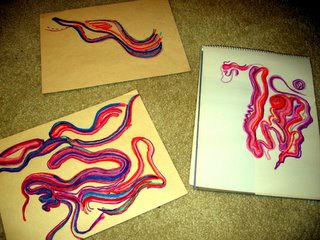Another creative courage strategy that works, reprinted from the Confidence & Courage Tips link on my link list to the left side of this site. Do give this one a shot; it's good for the just-back-from-the-holiday Monday.
Rise, Knight...
Slay The Dragons In Your Path...
Then Claim The Golden Crown
By Gabriel Daniels
The following is a powerful technique you can use to conquer your fears...and attain your dreams.
Imagine yourself being a brave knight, complete with armor, shield, helmet, and sword (or any weapon of your choice...ex. spear, bow and arrow, etc.). In other words, “act as if” you are a brave knight (one who has fought and won countless battles). You can do this with eyes open or closed...whichever you find more comfortable.
Stand the way a brave or fearless knight would stand. Breathe the way a brave knight would breathe. Gaze the way a brave knight would gaze. Feel yourself having the same kind of resolve and determination a brave knight would have.
And in your mind’s eye, focus on your target (your dream...visualize it vividly) in the distance (for the purpose of this article, let’s just use a “golden crown” as the target to symbolize your dream...when you’re applying this technique on your own, visualize exactly what it is you want instead of the golden crown), with such intensity, that you’re absolutely sure that nothing can stop you from attaining it. Better yet, believe that it’s already yours.
Imagine the golden crown with a bright light around it...as if it were drawing you towards it like a magnet...as if it were saying to you, “Come claim me. I’m yours.”
Then, in your mind’s eye, walk confidently and courageously towards the glowing crown. (If you wish to ride a horse instead, then go right ahead. You can even fly and do all kinds of acrobatics...just like what they do in The Matrix. Use your imagination to the fullest.)
And on your way to the crown, imagine one fire-breathing dragon after another flying towards you...trying to stop you from reaching the crown. (Include as many senses in your visualizations as possible. Hear the dragons’ wings flap. Hear the noise they make...including the sound of their breathing. See their huge, red eyes staring at you. Feel the heat of their breath. And so on.)
As each dragon comes towards you, strike it with your sword. And as your sword hits each one, imagine it getting blown to smithereens—just like the vampires in Buffy the Vampire Slayer or Blade. (If you wish, you can make it even more graphic. It’s up to you how you want to see the dragons defeated...how you want to see “your fears” defeated.) Use your imagination to the fullest. Don’t worry, no one will know you’re doing this. Remember, you’re merely visualizing all of this. So just go all out.
Let the glowing crown (your dream) in the distance inspire you to persist with courage and determination.
And when each dragon tries to breathe fire on you, simply use your shield to protect yourself. Imagine yourself being invincible as you continue to walk towards the brightly shining crown. Even though you feel intense heat all around you because of the fire coming from the dragons, it doesn’t bother you or make you retreat. You simply keep moving forward...with the confidence and conviction that nothing can get in your way.
Remember, you are a knight with absolute courage and unshakeable resolve. You are determined to get what you want...and absolutely nothing can stop you! In fact, nothing will stop you! The golden crown is as good as yours.
(Tip: As each dragon comes before you, you can label/name each one as a particular fear you may have. For example, as you look at the dragon before you, you can say, “Come on, rejection, let’s see what you’ve got.” Then without hesitation, strike the dragon with a quick swing of your sword...“POOF”...smithereens...like it was nothing. Or if a voice keeps playing in your head, telling you that you won’t succeed because you’re simply not good enough, bravely meet the dragon flying towards you and say, “You think you can stop me, negative critic? Well, you’re wrong! Take this!” Then drive your sword into the dragon’s body...“POOF”...smithereens. And continue to do this with each of your fears.)
Then after you’ve slain all the dragons, walk up to the golden crown and reach for it. Claim it. Hold it proudly with both hands and place it firmly on your head...knowing you deserve it. And as you do that, smile and experience the great feeling of victory.
Do this regularly or whenever you find all kinds of doubts, fears, worries, etc., creeping in. Then you will notice a difference in your attitude towards them...in the real world. You will feel like nothing can get in your way as you pursue your dreams.
So, now, I say to you, “Rise, knight. Slay the dragons in your path. Then claim the golden crown.”
About the Author:
Gabriel Daniels publishes Confidence & Courage Tips...To Help You Realize Your Dreams. For tips, strategies, stories, quotes, and more...to inspire and empower you to take action...so you can get what you want out of life, visit his website at: http://confidencetips.blogspot.com
You are free to reprint this article in your ezine or newsletter, or on your website, as long as you include this resource box—and as long as the article’s contents are not changed in any way.



